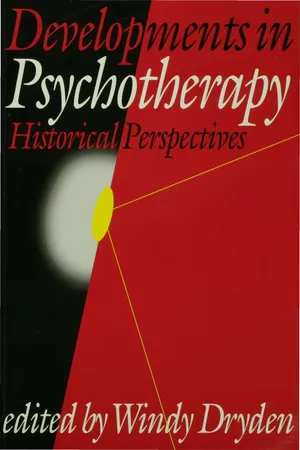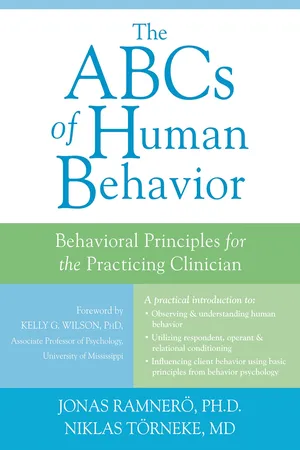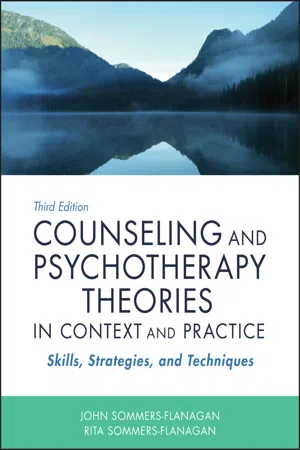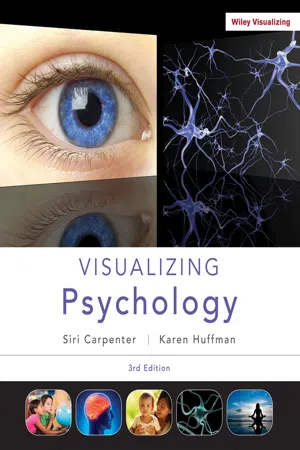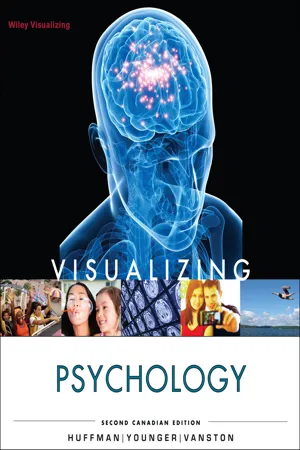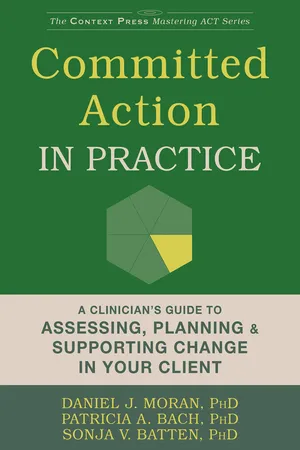Psychology
Behavioral Therapies
Behavioral therapies are a type of psychological treatment that focuses on changing maladaptive behaviors through techniques such as conditioning, reinforcement, and modeling. These therapies are based on the principles of learning theory and emphasize the role of environmental factors in shaping behavior. They are often used to treat various mental health conditions, including anxiety disorders, phobias, and substance abuse.
Written by Perlego with AI-assistance
Related key terms
1 of 5
12 Key excerpts on "Behavioral Therapies"
- eBook - PDF
Introduction to Clinical Psychology
Bridging Science and Practice
- Douglas A. Bernstein, Bethany A. Teachman, Bunmi O. Olatunji, Scott O. Lilienfeld(Authors)
- 2020(Publication Date)
- Cambridge University Press(Publisher)
Applicable to numerous psychological problems, behavior ther- apy techniques are designed to help clients learn to change their problematic behaviors and/or the environmental circumstances that support those behaviors. Behavior therapy is not a single method but rather a large collection of techniques designed to address people’s psychological problems. Included are exposure therapies, behavioral acti- vation and contingency management approaches that build on reinforcement principles, relaxation training, biofeedback, assertiveness training, and many others (Antony & Roemer, 2011a). Many of these techniques, such as exposure and behavioral activation, are applied in treatment programs for 286 | a wide variety of disorders. Behavioral techniques are used by theorists from a wide spectrum of clinical orientations to treat both children and adults. They tend to be active approaches that use information about what functions various behaviors serve for a person so as to increase helpful behaviors and decrease unhelpful ones. Behavior therapy A collection of learning-based treatment techniques that includes exposure therapies, behavioral activation, and contingency management. Theoretical Foundations The key assumption underlying behavioral approaches to therapy is that the behaviors seen in psychological problems develop through the same laws of learning that influence the develop- ment of other behaviors. So behaviorists see most disorders not as “things” that people have, but as reflections of how the principles of learning have influenced people to behave in particular situ- ations. Our understanding of these principles of learning has emerged from research on classical conditioning, operant conditioning, and observa- tional learning. - eBook - PDF
- Douglas Bernstein, , , (Authors)
- 2015(Publication Date)
- Cengage Learning EMEA(Publisher)
Zigy Kaluzny/Stone/Getty Images Copyright 2016 Cengage Learning. All Rights Reserved. May not be copied, scanned, or duplicated, in whole or in part. Due to electronic rights, some third party content may be suppressed from the eBook and/or eChapter(s). Editorial review has deemed that any suppressed content does not materially affect the overall learning experience. Cengage Learning reserves the right to remove additional content at any time if subsequent rights restrictions require it. 546 Treatment of Psychological Disorders become a popular alternative to psychodynamic and humanistic methods (Miltenberger, 2011). The most notable features of behavioral treatment include the following: 1. Development of a productive therapist-client relationship. As in other therapies, this relationship enhances clients’ confidence that change is possible and makes it easier for them to speak openly and to cooperate in and benefit from treatment (Emmelkamp, 2013). 2. A careful listing of the behaviors and thoughts to be changed (Umbreit et al., 2006). This assessment and the establishment of specific treatment goals sometimes re-place the formal diagnosis used in some other therapy approaches. So, instead of treating “depression” or “obsessive-compulsive disorder,” behavior therapists work to change the specific thoughts, behaviors, and emotional reactions that lead peo-ple to receive these diagnostic labels. 3. A therapist who acts as a teacher/assistant by providing learning-based treatments, giving “homework” assignments, and helping the client make specific plans for dealing with problems rather than just talking about them (Kazantizis et al., 2010). 4. Continuous monitoring and evaluation of treatment, and constant adjustments to any procedures that do not seem to be effective (Farmer & Nelson-Gary, 2005). Because ineffective procedures are soon altered or abandoned, behavioral treat-ment tends to be one of the briefer forms of therapy. - eBook - PDF
Developments in Psychotherapy
Historical Perspectives
- Windy Dryden(Author)
- 1996(Publication Date)
- SAGE Publications Ltd(Publisher)
In this way, behaviour therapists share with behavioural psychologists from non-clinical fields an emphasis on overt behaviour. As wel l as this emphasis, behaviour therapists have taken from academic psychology an insistence on rigorous evaluation of their interventions and many of the investigation methods used in behavioural psychology. Indeed, in an examination of the meaning of being a behaviour therapist, Thoresen and Coates (1978) note the strong identification of the therapy with scientific principles and methods. They examine five complementary definitions of behaviour therapy: applied learning theory, application of results and methods of experimental behavioural science , experimental study of change 168 Developments in Psychotherapy processes, controlled experimental studies of the single case, and technical eclecticism. Whilst each of these definit ions has excited controversy during the history of behaviour therapy, they all site behaviour therapy clearly within the tradi tion of empiric ism. Thoresen and Coates conclude by suggesting that therapy is best practised and evaluated within this scient ific tradition, and characterize the behaviour therapis t as one who challenges the non-scientific myths of other therapeutic tradit ions. At its best, behaviour therapy is, therefore, 'scientific ', in this broad sense of subjecting the therapeutic process to empir ical tes ting. Behaviour therapis ts seek to engage clients as partic ipants in therapeu tic 'experiments ', which at tempt to establish the relevance of conditioning theories to clients' difficult ies. Therapy is also eclectic, drawing on many techniques, challeng-ing of orthodoxy, humanistic (since it seeks to assert the individuality of clients' experiences and difficulties, rather than to ascribe to them mental 'illnesses ' which different iate them from the rest of the population), pragmatic, and driven princ ipally by technique rather than relationsh ip. - eBook - PDF
- Nancy Ogden, Michael Boyes, Evelyn Field, Ronald Comer, Elizabeth Gould(Authors)
- 2021(Publication Date)
- Wiley(Publisher)
As you may recall from Chapter 15, behaviourists contend that the symp- toms of a psychological disorder are learned behaviours acquired through the same conditioning processes that produce normal behaviours (Stad- don, 2014). The goal of behavioural therapy is to identify the client’s specific problem-causing behaviours and to replace them with more adaptive behav- iours. The therapist’s attitude toward the client is that of a teacher, rather than a healer. Behavioural techniques fall into three categories: classical con- ditioning, operant conditioning, and modelling. Classical Conditioning Techniques Classical conditioning treatments are intended to change clients’ dysfunc- tional reactions to stimuli. One treatment, described in Chapter 7, is systematic desensitization. This step-by-step process is aimed at teaching people with phobias to react with calm instead of fear to the objects or situations they dread (Fishman, Rego, & Muller, 2011; Wolpe, 1997a, 1997b, 1995, 1990). Cli- ents first are trained in deep-muscle relaxation, through deep breathing, calming mental imagery, and systematic tensing and releasing of muscles. Next, they construct a fear hierarchy in which they list objects or situations associated with their phobia, starting with the least feared and ending with the most feared. For a client with a phobia of elevators, for example, looking at an elevator on the outside of a building a block away might be low on the fear hierarchy; watching the elevator doors close while inside the elevator might be near the top (see Figure 16.3). Finally, either in imagination or phys- ically, clients confront each item on the hierarchy while they are in a state of deep relaxation, starting with the least fearful and then moving on up the list. - eBook - PDF
- Torneke, Niklas, Ramnero, Jonas(Authors)
- 1010(Publication Date)
- Context Press(Publisher)
INTRODUCTION Building on Behaviorism: Cognitive/Behavioral Therapies, Behavioral Psychotherapy, and Functional Contextualism Even though this book is based specifically on learning theory and has behaviorism as its point of reference, we believe there is a need to start by relating its content to the wider world of both behavioral and cognitive therapies. Let’s turn to that topic now. COGNITIVE/Behavioral Therapies Cognitive and Behavioral Therapies have undergone significant development over the past twenty years. Scientific support has grown along with interest from society at large. The therapies are practiced in different ways, but therapists typically use a mixture of techniques from both perspectives, most of the time under the heading of CBT (cogni- tive behavioral therapy). However, there is an inherent tension in this mixing. While traditional behavior therapy is a clinical application of learning theory, cognitive therapy is based on a model of information processing. Of the two, the cognitive model has dominated, at least since the 1980s, the theoretical aspect of CBT. One probable reason for this dominance is that several successful treatment models have developed from a cognitive perspective. Another might be the fact that classical learning theory has had problems dealing with some typically human phenomena, such as the power and func- tion of thought. Even though behaviorism and well-researched principles of learning are implicit in the CBT tradition, the epistemologically more critical view of science in the tradition of behaviorism has often been pushed into the background. 2 The ABCs of Human Behavior In the last few years, interest in classical learning theory has increased. Several new treatment models, explicitly based on behavioral philosophy, have developed. The best known is probably DBT (dialectical behavior therapy). At the same time, there has been a growing debate about the scientific foundation of CBT. - eBook - PDF
Theories of Psychotherapy & Counseling
Concepts and Cases
- Richard Sharf(Author)
- 2020(Publication Date)
- Cengage Learning EMEA(Publisher)
Of these four sources of self-efficacy, Bandura believes that the stron-gest factor is an individual’s performance accomplishments. Despite the many theories of behavior and its impact on personality, basic for most behavior therapists are the principles of reinforcement and observational learning. They have been used in a variety of ways to develop techniques to help individuals change covert and overt behavior. Theories of Behavior Therapy There are no overriding theories of behavior therapy; rather, techniques have been developed that are consistent with basic principles of behavior and a few theories that are designed to treat specific disorders. Goals of behavior therapy are situationally specific, depending on the desired behavior change. Similarly, assessment focuses on reports and observations of client behaviors in real and simulated situations. With this information, behavior therapists use a variety of techniques, such as systematic desensitization, which can reduce fears and anxi-eties. Sometimes behavior therapists work with the actual situation in which an event has occurred; other times, they may have the client imagine an event. In addition, behavior therapists have developed a variety of strategies to model and teach new behaviors. By combining behavioral approaches with self-instruction and other cognitive techniques, some therapists have developed additional creative approaches to help clients cope more effectively with their problems. Goals of Behavior Therapy A distinguishing feature of behavior therapy is its emphasis on the specificity of goals. Early in their work with patients, behavior therapists focus on changing target behaviors —that is, behaviors that can be defined clearly and accurately. They identify the actions or events that explain why an individual persists in a certain Copyright 2016 Cengage Learning. All Rights Reserved. May not be copied, scanned, or duplicated, in whole or in part. - eBook - PDF
Counseling and Psychotherapy Theories in Context and Practice
Skills, Strategies, and Techniques
- John Sommers-Flanagan, Rita Sommers-Flanagan(Authors)
- 2018(Publication Date)
- Wiley(Publisher)
Either classical or operant conditioning can explain successful outcomes associated with assertiveness train-ing. For example, Wolpe would have considered asser-tive behavior as incompatible with anxiety; when anxiety is counterconditioned, assertive behavior may emerge (Wolpe, 1973). In contrast, contemporary assertiveness trainers usually focus more on operant conditioning contingencies—reinforcements and punishments—that establish and maintain passive, aggressive, and assertive social behavior (Alberti & Emmons, 2017). As a means of better understanding client psychopa-thology, behaviorists apply scientific methods to clinical or counseling settings. Behaviorists systematically: • Observe and assess client maladaptive or unskilled be-haviors. • Develop hypotheses about the cause, maintenance, and treatment for maladaptive or unskilled behaviors. • Test behavioral hypotheses with empirically supported interventions. • Observe and evaluate the results of their intervention. • Revise and continue testing new hypotheses about how to modify maladaptive or unskilled behavior(s) as needed. Behaviorists are on the cutting edge when it comes to applying specific treatment procedures to specific clinical problems. More than any other practitioner group, behav-ior (and cognitive behavior) therapists insist on empirical support for their treatment methods. Consequently, most empirically supported treatments (ESTs) are behavioral or cognitive behavioral (Chambless et al., 1998, 2006). THE PRACTICE OF BEHAVIOR THERAPY When preparing to do behavior therapy, be sure to get out your clipboard, because behavior therapists take notes, think like scientists, and act like educators. You may even need graph paper or a white board for illustrating concepts to clients. Your job is to help cli-ents unlearn old, maladaptive behaviors and learn new, adaptive behaviors. A sample excerpt from a behavioral informed consent is in Putting It in Practice 7.1. - eBook - PDF
- Siri Carpenter, Karen Huffman(Authors)
- 2012(Publication Date)
- Wiley(Publisher)
Evaluating Behavior Therapies Behavior therapy has been effective with various prob-lems, including phobias, obsessive-compulsive disorder, eating disorders, sexual dysfunctions, autism, intellectual disabilities, and delinquency (Antony & Roemer, 2011; Haynes, O’Brien, & Kaholokula, 2011; Miltenberger, 2011; Truscott, 2010). Critics of behavior therapy, however, raise important questions that fall into two major categories: • Generalizability Critics argue that in the “real world” patients are not consistently reinforced, and their newly acquired behaviors may disappear. To deal with this possibility, behavior therapists work to gradually shape clients toward real-world rewards. • Ethics Critics contend that it is unethical for one person to control another’s behavior. Behaviorists, however, 1. What is the function of a fear hierarchy? 2. How can shaping be used to develop desired behaviors? 3. How could participant modeling help someone to overcome severe shyness? 4. How could behavior therapy be unethical? argue that rewards and punishments already control our behaviors and that behavior therapy actually increases a person’s freedom by making these controls overt and by teaching people how to change their own behavior. Biomedical Therapies LEARNING OBJECTIVES 1. Identify the major types of drugs used to treat psychological disorders. 2. Explain what happens in electroconvulsive therapy and psychosurgery. 3. Describe the risks associated with biomedical therapies. RETRIEVAL PRACTICE While reading the upcoming sections, respond to each Learning Objective in your own words. Then compare your responses with those in Appendix B. ome problem behaviors seem to be caused, at least in part, by chemical imbalances or disturbed nervous system functioning, and so can be treat-ed with biomedical therapies . - eBook - PDF
- Karen R. Huffman, Alastair Younger, Claire Vanston(Authors)
- 2013(Publication Date)
- Wiley(Publisher)
family therapy Treatment to change maladaptive interaction patterns within a family. Jean Gill/iStockphoto Behaviour Therapies 395 Behaviour Therapies LEARNING OBJECTIVES 1. Identify a key difference between these two classical conditioning techniques: systematic desensitization and aversion therapy. 2. Explore how operant conditioning can be used in therapy. 3. Summarize how modelling therapy works. ometimes having in- sight into a problem does not automati- cally solve it. In be- haviour therapy, the focus is on the problem behaviour itself, rath- er than on any underlying causes. Although the person’s feelings and interpretations are not disregarded, they are just not emphasized. The therapist diagnoses the problem by listing the maladaptive behav- iours that occur and the adaptive behaviours that are ab- sent. The therapist then attempts to shift the balance of the two, drawing on the principles of classical conditioning, op- erant conditioning, and observational learning (Chapter 6). Classical Conditioning Techniques Behaviour therapists use the principles of classical con- ditioning to decrease maladaptive behaviours by creating new associations to replace the faulty ones. We will ex- plore two techniques based on these principles: systematic desensitization and aversion therapy. Systematic desensitization is a widely used behav- ioural approach for the treatment of phobias (Wolpe & Plaud, 1997). The theoretical premise behind this ap- proach is that phobias are emotional responses that have been classically conditioned to certain environmental stimuli (Chapter 6). For example, the emotional response associated with a terrifying automobile accident may be- come conditioned to sitting in the driver’s seat of a car (a previously neutral stimulus). The person then experiences terror simply upon sitting behind the wheel (Kowalski & Westen, 2011). - eBook - PDF
Psychology and the Challenges of Life
Adjustment and Growth
- Spencer A. Rathus, Jeffrey S. Nevid(Authors)
- 2019(Publication Date)
- Wiley(Publisher)
Like client-centered therapists, behavior therapists remain very much in the present— the here and now. Although they understand that past is prelude to the present, they argue that we can only change behavior in the present. Unlike psychodynamic and client- centered therapists, behavior therapists are directive; they devise specific programs of behavior change for their clients. Behavior therapists, like other therapists, seek to develop warm, therapeutic relationships with clients, but they believe that the effectiveness of their techniques derives from specific, learning-based procedures rather than the therapeutic relationship. They also insist that their methods be tested through controlled research and outcomes assessed in terms of measurable behavior. Behavior therapists use a variety of learning-based techniques. Fear-Reduction Methods Many people seek the services of behavior therapists because of fears and phobias that inter- fere with their functioning. Behavior therapists use a variety of techniques to help people overcome these problems, including flooding, gradual exposure, systematic desensitization, counterconditioning, and modeling. Flooding Flooding is based on the learning-theory principle of extinction (see Chapter 3). In this method, a person is exposed for prolonged intervals to a fear-evoking but harmless stimulus until the fear is extinguished. For example, an individual with a fear of heights might try to remain for as long as possible in a height situation, or at least as long as it takes for the fear to dissipate. Because flooding engenders high levels of anxiety, the therapist or another helper may be present to assist the person during these encounters. Gradual Exposure Gradual exposure is similar to flooding in that it relies on exposure to fearful stimuli. But unlike flooding, the person is first exposed to minimally fearful stimuli and then gradually works upward in a hierarchy (ordered series) of progressively more fearful stimuli. - eBook - PDF
- Batten, Sonja V., Bach, Patricia A., Moran, Daniel J.(Authors)
- 2018(Publication Date)
- Context Press(Publisher)
In addition, research has shown that clinicians can offer similar therapeutic approaches for different disorders (Harvey, Watkins, Mansell, & Shafran, 2004). Further, when one clinically relevant concern is treated, it can also lead to improvements in a comorbid disorder that has not been directly treated (Borkovec, Abel, & Newman, 1995). For several of these reasons, there is a growing trend among behavioral scientists to think about clinical issues from a functional approach, rather than a structural catego- rization system of diagnoses as if the behavioral concerns were discrete illnesses. At the same time, behavioral scientists must also recognize that the current context of clinical psychological treatment embraces the DSM nosology, and that a system of categoriza- tion cannot practically be ignored. Finding the balance between the conventionally accepted language of the DSM and the transdiagnostic, functional contextual way of thinking will require flexibility from the ACT clinician. In order to maintain a link to mainstream clinical psychology, and because it is often prudent and workable to main- tain the broad, conventional way of talking about clinical issues when selecting appro- priate treatments, this chapter will follow the APA Division 12 use of the DSM’s diagnostic approach to identifying evidence-based psychotherapies. Exploring Evidence-Based Psychotherapies In the late 20 th century, there was a clamoring for evidence for the effectiveness of the psychological treatments that mental health practitioners were using. Third-party payors, patient advocates, and behavioral scientists were interested in making sure that interventions were efficient and successful for reducing suffering and improving quality Reviewing Evidence-Based Psychotherapies 119 of living. Responsible applied scientists wanted to reduce quackery that could be found in psychotherapy, and start to sharpen the clinician’s focus on how to improve thera- peutic outcomes. - eBook - PDF
- Ronald Comer, Elizabeth Gould, Adrian Furnham(Authors)
- 2014(Publication Date)
- Wiley(Publisher)
Here, a man savours a drink just before the effects of a nauseating drug begin. aversion therapy a therapy designed to help clients to acquire anxiety responses to stimuli that they have been finding too attractive. BEHAVIOURAL THERAPIES 589 Operant Conditioning Techniques In operant conditioning treatments, therapists consist- ently provide rewards for appropriate behaviour and with- hold rewards for inappropriate behaviour. This technique has been employed frequently, and successfully, with hos- pitalized patients experiencing psychosis (Kopelowicz et al., 2007; Paul & Lentz, 1977; Ayllon & Azrin, 1965). When such patients talk coherently and behave nor- mally, they are rewarded with food, privileges, attention or something else they value. Conversely, they receive no rewards when they speak bizarrely or display other psy- chotic behaviours. Parents, teachers and therapists have successfully used operant conditioning techniques to change challenging behaviours in children, such as repeated tantrums, and to teach skills to individuals with autism or learning disabilities (Soorya et al., 2011; Spiegler & Guevremont, 2003). Rewards in such cases have included food, TV and trips out etc. Operant conditioning techniques typically work best in institutions or schools, where a person ’s behaviour can be reinforced systematically throughout the day. Often, a whole ward or classroom is converted into an operant conditioning arena. In many such programmes, desirable behaviour is reinforced with tokens that can later be exchanged for food, privileges or other rewards (Ayllon & Azrin, 1968). Pro- grammes of this sort are called token economy programmes. Behavioural techniques based on operant condition- ing have also been useful for depression (Lazzari et al., token economy an operant conditioning therapy programme in which partici- pants receive tokens (that can be traded for rewards) when they display desired behaviours.
Index pages curate the most relevant extracts from our library of academic textbooks. They’ve been created using an in-house natural language model (NLM), each adding context and meaning to key research topics.


